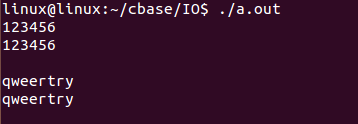线程间通信
参考博客:https://blog.csdn.net/a987073381/article/details/52029070
推荐博客:pthread_mutex_t
线程间通信,一般指的是同一进程中的不同线程通信。不同进程中的线程通信其实属于进程间通信。
线程间通信方式:
1、全局变量:进程中线程间共享内存。同一进程中的不同线程共享同一全局内存区域,包括初始化数据段,未初始化数据段以及堆内存数据段。因此线程间可以方便、快速的共享信息。只需要将数据复制到共享(全局/堆)变量中即可。
注:要避免多个线程试图同时修改同一份信息。
定义全局变量时最好使用volatile定义,以防编译器对此变量优化。
下图为多线程的进程地址空间:

2、Message消息机制
3、CEvent对象
线程安全
进程中的多个线程同时运行,当多个线程同时访问一段代码时,若每次运行结果和单线程运行结果一样,其他变量的值也和预期值一样,那么线程就是安全的,即多线程访问同一段代码不会产生不确定结果。如何保证线程安全——线程间同步。
线程间同步:
同步指的是多个任务按照约定的先后次序互相配合完成一件事情。Dijikstra基于信号量的概念,提出一个同步机制——由信号量来决定线程是否继续运行还是阻塞。
线程间同步的信号量采用POSIX的信号量接口。
信号量代表某一类资源,其值代表系统中该资源的数量。信号量是一个受保护的变量,只能通过三种操作来访问:
1)初始化
2)P操作(申请资源)
3)V操作(释放资源)
pthread库常用信号量操作函数如下:
1 #include <semaphore.h> 2 3 sem_t sem_event; 4 int sem_init(sem_t *sem, int pshared, unsigned int value);//初始化一个信号量 5 int sem_destroy(sem_t * sem); //销毁信号量 6 int sem_post(sem_t * sem); //V操作:信号量增加1, 7 int sem_wait(sem_t * sem); //P操作:信号量减少1,如果信号量计数是0就会发生阻塞。直到成功使信号量减1 8 int sem_getvalue(sem_t * sem, int * sval); //获取当前信号量的值
测试:写线程,读线程对buf实现PV操作。
1 #include <pthread.h> 2 #include <stdio.h> 3 #include <stdlib.h> 4 #include <string.h> 5 #include <semaphore.h> 6 7 char buffer[100]; 8 sem_t sem; //定义信号量 9 10 void *write(void* arg) 11 { 12 //detach改变线程状态为unjoinable, 13 //在线程结束后,会自动回收资源 14 pthread_detach(pthread_self()); 15 while(1) 16 { 17 fgets(buffer,20,stdin); //通过键盘输入 18 sem_post(&sem); //写线程,写后释放资源. 19 } 20 } 21 //read和write中的两个while循环,程序运行后会一直在这两个线程的while切换进行写-读 22 void *read(void* arg) 23 { 24 pthread_detach(pthread_self()); 25 while(1) 26 { 27 memset(buffer,0,100); 28 sem_wait(&sem); //读线程等待写线程的资源,就算先调用read,但因value=0,wait函数阻塞,直到value加1,之后再wait之后减1 29 printf("%s ",buffer); //等待写进程释放资源后,退出阻塞,执行至此打印buf内容 30 } 31 } 32 33 int main() 34 { 35 int re,i=0; 36 pthread_t tid1,tid2; 37 //pshared 控制信号量的类型,值为 0 代表该信号量用于多线程间的同步,值如果大于 0 表示可以共享,用于多个相关进程间的同步 38 sem_init(&sem,0,0); //参数:信号量对象,默认0 39 40 re = pthread_create(&tid1,NULL,read,(void *)i); 41 if(re!=0) 42 { 43 printf("pthread_create:%s ",strerror(re)); 44 exit(0); 45 } 46 47 re = pthread_create(&tid2,NULL,write,(void *)i); 48 if(re!=0) 49 { 50 printf("pthread_create:%s ",strerror(re)); 51 exit(0); 52 } 53 54 while(1) //一直阻塞在此,否则顺序执行下来,就直接退出了,对应线程也不会执行。可以使用pthread_join等待线程退出 55 sleep(1); 56 }
结果:

写线程通过键盘输入将内容写入buf,释放sem,探测sem有资源,读线程读buf,打印。
多个线程实现同步,定义多个信号量

1 #include<stdio.h> 2 #include <pthread.h> 3 #include <semaphore.h> 4 5 6 #define N 64 7 typedef struct message{ 8 char buf[N]; 9 int len; 10 }msg_t; 11 12 sem_t sem_reverse; //定义用于逆置的信号量 13 sem_t sem_printf; //定义用于打印的信号量 14 15 void* reverse_msgbuf(void* arg) 16 { 17 msg_t *msg = (msg_t *)arg; 18 int i = 0; 19 char tmp; 20 while(1){ 21 sem_wait(&sem_reverse); 22 printf("reverse_msgbuf ------------- "); 23 //printf("hello reverse_msgbuf. "); 24 #if 1 25 for(i = 0; i < msg->len/2; i ++){ 26 tmp = msg->buf[i]; 27 msg->buf[i] = msg->buf[msg->len - i - 1]; 28 msg->buf[msg->len - i -1] = tmp; 29 } 30 #endif 31 sleep(1); 32 printf("reverse_msgbuf :%s ",msg->buf); 33 sem_post(&sem_printf); 34 } 35 } 36 37 void* printf_msgbuf(void* arg) 38 { 39 msg_t *msg = (msg_t *)arg; 40 while(1){ 41 sem_wait(&sem_printf); 42 printf("printf_msgbuf :*********** "); 43 printf("printf_msgbuf :%s ",msg->buf); 44 sem_post(&sem_reverse); 45 } 46 } 47 48 int main(int argc, const char *argv[]) 49 { 50 msg_t msg = {"123456789",9}; 51 pthread_t tid[2]; 52 53 //初始化信号量 54 sem_init(&sem_reverse,0,1); //value=1,表示有资源可用,即让reverse先执行 55 sem_init(&sem_printf,0,0); //实现先逆置在打印,先逆置在打印,以此循环 56 57 pthread_create(&tid[0],NULL,reverse_msgbuf,(void *)&msg); 58 pthread_create(&tid[1],NULL,printf_msgbuf,(void *)&msg); 59 60 pause(); 61 62 return 0; 63 }
线程互斥:
前面提到了同步,同步是一种直接制约关系,是指多个线程(或进程)为了合作完成任务,必须严格按照先后次序来运行。如上的读写操作,必须先进行写操作,写入内容,才可执行读操作,且写的过程不可以读。
互斥,是一种间接制约关系,指系统中的一些共享资源(临界资源),当访问了解资源时,其他线程必须等待。
互斥量本质上说是一把锁,在访问共享资源前对互斥量进行上锁,在访问完成后释放互斥量。对互斥量进行上锁以后,其他试图再次对互斥量加锁的线程都会被阻塞,直到当前线程释放该互斥锁。
1 #include <pthread.h> 2 3 /********互斥锁初始化********/ 4 int pthread_mutex_init(pthread_mutex_t *mutex, const pthread_mutexattr_t *mutexattr); 5 6 //成功返回0,失败返回错误码 7 //mutex指向要初始化的互斥锁对象 8 //attr 互斥锁属性,NULL缺省 9 10 eg.pthread_t mutex; 11 pthread_mutex_init(&mutex, NULL); 12 13 /*******互斥锁上锁**********/ 14 int pthread_mutex_lock(pthread_mutex_t *mutex); 15 //成功返回0,失败返回错误码 16 //mutex指向要初始化的互斥锁对象 17 //如果无法获得锁,任务阻塞 18 19 /********互斥锁解锁********/ 20 int pthread_mutex_unlock(pthread_mutex_t *mutex); 21 //成功返回0,失败返回错误码 22 //mutex指向要初始化的互斥锁对象 23 //执行完临界区要及时释放锁
测试程序:
创建两个写线程write1、write2,分别向缓冲区写入字符串:I am pthread_write1与I am pthread_write2。并打印输出。
分析:可以分别在线程写前后加互斥锁,解互斥锁。
加互斥锁前:

1 #include <pthread.h> 2 #include <stdio.h> 3 #include <stdlib.h> 4 #include <string.h> 5 #include <semaphore.h> 6 7 FILE *fp; //定义文件流指针 8 9 void *write1(void* arg) 10 { 11 char *c1 = "I am pthread_write1"; 12 char *c2; 13 int len,i; 14 len = strlen(c1); 15 pthread_detach(pthread_self()); 16 c2 = c1; 17 while(1) 18 { 19 for(i=0;i<len;i++) 20 { 21 fputc(*c1,fp); //每次写一个字符 22 fflush(fp); 23 c1++; //指针移动 24 usleep(10000); //挂起10000微秒即10毫秒 25 } 26 c1 = c2; //恢复指针到字符串头部 27 sleep(1); 28 } 29 } 30 31 void *write2(void* arg) 32 { 33 int len,i; 34 char *c2; 35 char *c1 = "I am pthread_write2"; 36 len = strlen(c1); 37 c2 = c1; 38 pthread_detach(pthread_self()); 39 while(1) 40 { 41 for(i=0;i<len;i++) 42 { 43 fputc(*c1,fp); 44 fflush(fp); 45 c1++; 46 usleep(10000); 47 } 48 c1 = c2; 49 sleep(1); 50 } 51 } 52 53 int main() 54 { 55 int re,i=0; 56 pthread_t tid1,tid2; 57 58 fp = fopen("1.txt","w"); 59 if(!fp) 60 { 61 perror("fopen"); 62 return -1; 63 } 64 re = pthread_create(&tid1,NULL,write1,(void *)i); 65 if(re!=0) 66 { 67 printf("pthread_create:%s ",strerror(re)); 68 exit(0); 69 } 70 71 re = pthread_create(&tid2,NULL,write2,(void *)i); 72 if(re!=0) 73 { 74 printf("pthread_create:%s ",strerror(re)); 75 exit(0); 76 } 77 78 while(1) 79 { 80 sleep(1); 81 } 82 }

写入文件中的内容乱序。
加锁后:

1 #include <pthread.h> 2 #include <stdio.h> 3 #include <stdlib.h> 4 #include <string.h> 5 #include <semaphore.h> 6 7 FILE *fp; //定义文件流指针 8 9 pthread_mutex_t mutex; //定义锁 10 11 void *write1(void* arg) 12 { 13 char *c1 = "I am pthread_write1 "; 14 char *c2; 15 int len,i; 16 len = strlen(c1); 17 pthread_detach(pthread_self()); 18 c2 = c1; 19 while(1) 20 { 21 pthread_mutex_lock(&mutex); //上锁 22 for(i=0;i<len;i++) 23 { 24 fputc(*c1,fp); //每次写一个字符 25 fflush(fp); 26 c1++; //指针移动 27 usleep(10000); //挂起10000微秒即10毫秒 28 } 29 pthread_mutex_unlock(&mutex); //解锁 30 c1 = c2; //恢复指针到字符串头部 31 sleep(1); 32 } 33 } 34 35 void *write2(void* arg) 36 { 37 int len,i; 38 char *c2; 39 char *c1 = "I am pthread_write2 "; 40 len = strlen(c1); 41 c2 = c1; 42 pthread_detach(pthread_self()); 43 while(1) 44 { 45 pthread_mutex_lock(&mutex); 46 for(i=0;i<len;i++) 47 { 48 fputc(*c1,fp); 49 fflush(fp); 50 c1++; 51 usleep(10000); 52 } 53 pthread_mutex_unlock(&mutex); 54 c1 = c2; 55 sleep(1); 56 } 57 } 58 59 int main() 60 { 61 int re,i=0; 62 pthread_t tid1,tid2; 63 64 pthread_mutex_init(&mutex,NULL); //锁初始化 65 fp = fopen("1.txt","w"); 66 if(!fp) 67 { 68 perror("fopen"); 69 return -1; 70 } 71 re = pthread_create(&tid1,NULL,write1,(void *)i); 72 if(re!=0) 73 { 74 printf("pthread_create:%s ",strerror(re)); 75 exit(0); 76 } 77 78 re = pthread_create(&tid2,NULL,write2,(void *)i); 79 if(re!=0) 80 { 81 printf("pthread_create:%s ",strerror(re)); 82 exit(0); 83 } 84 85 while(1) 86 { 87 sleep(1); 88 } 89 }

注:一个互斥量表示的是一个临界资源,
如果多个线程会对同一个临界资源进行访问,又想让他们互斥执行,就为他们定义同一个互斥量。
如果各自有各自的临界资源,希望自己在执行的时候,不被其他线程打断,就单独为自己定义一个互斥量。
1、关于互斥锁与条件变量的使用见博客:
条件变量pthread_cond_t怎么用
pthread_mutex_t
2、pthread_join与 pthread_detach详见:
https://baike.baidu.com/item/pthread_join
2、unjoinable属性可以在pthread_create时指定,或在线程创建后在线程中pthread_detach自己, 如:pthread_detach(pthread_self()),将状态改为unjoinable状态,确保资源的释放。或者将线程置为 joinable,然后适时调用pthread_join.
pshared 控制信号量的类型,值为 0 代表该信号量用于多线程间的同步,值如果大于 0 表示可以共享,用于多个相关进程间的同步
